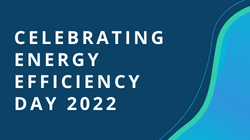 When Energy Efficiency Day was created in 2016, it had a simple mission in mind: “Save money. Cut pollution. Create Jobs.” Since then, it has become an occasion to promote strategies to increase energy efficiency and bring awareness to its importance. Falling on the first Wednesday in October each year, this year’s Energy Efficiency Day will be October 5th.
When Energy Efficiency Day was created in 2016, it had a simple mission in mind: “Save money. Cut pollution. Create Jobs.” Since then, it has become an occasion to promote strategies to increase energy efficiency and bring awareness to its importance. Falling on the first Wednesday in October each year, this year’s Energy Efficiency Day will be October 5th.
In short, energy efficiency means using less energy for the same outcome. It’s a simple concept, but one that has a sweeping impact. According to the IEA, energy efficiency could drive more than 40% of the overall reduction of energy-related greenhouse gas emissions over the next 20 years. Greater energy efficiency also makes energy more affordable and increases energy equity through lowering the financial burden of energy. As we work towards becoming a more sustainable society, energy efficiency plays a key role through these benefits.
Thanks to modern technology, energy efficiency has become much easier to achieve. New fixtures across technologies are being made with energy efficiency in mind, so saving energy can be as simple as installing an LED light bulb. Energy efficiency includes more than just lighting, though LEDs are perhaps one of the most well-known switches at this point. There are more efficient alternatives being created to replace almost every appliance in our buildings, including HVAC units, water heaters, refrigerators, and even technology like televisions. While there are many ways to find these more efficient technologies, you can get started with ENERGY STAR’s list of certified product categories to start learning more
When it comes to installing more efficient fixtures, sticker shock often causes people to pause. It’s true that the upfront costs for the most recent, efficient technologies can be higher than their less efficient counterparts. However, they quickly pay for themselves, with a single family home saving up to $500 a year on their utility bills as of 2018. With energy efficiency increasings, these savings will be even greater, and scaled up even more for larger buildings. To alleviate the upfront costs, financial incentives from various rebate programs are available. Rebates help to drive down the costs of an energy efficiency upgrade and motivate people to take the leap.
Aside from the environmental impacts, investment in energy efficiency will also boost the economy and create more jobs. A report by the American Council for an Energy Efficient Economy suggests that a $15 million investment in energy efficiency will create 420 more jobs than the status quo for the energy sector. That 420 includes not just contractors, but manufacturers and other suppliers for the building industry and jobs created by introducing more money into the local economy. Jobs in clean energy represent the largest amount of jobs in the energy sector and are set to increase even further as we invest more into energy efficiency.
To learn more about Energy Efficiency Day, visit https://energyefficiencyday.org/ for more resources about energy efficiency and to pledge your support. Join us on October 5th with the hashtag #EEDay2022 to see how people across the country are showing their support for the mission.
Ready to learn more about energy efficiency products and how to use rebates to inspire projects? Contact Encentiv Energy to get started!
.png?width=500&name=2019%20e%20news%20spotlight%20logo%20(1).png)



